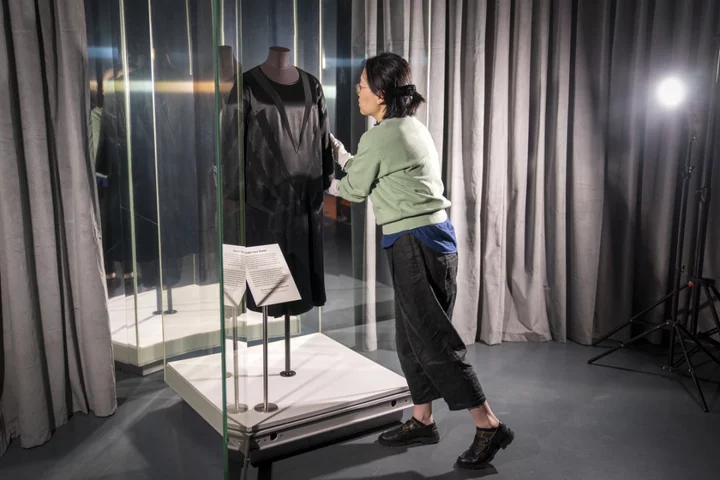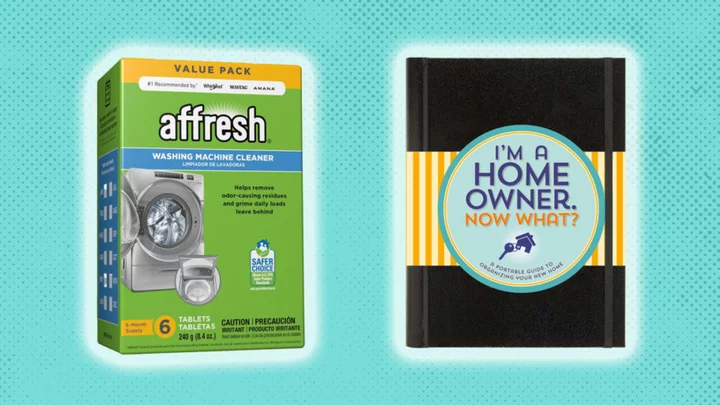
From Lupita Nyong’o and Jessica Chastain: 6 of our favourite looks at the 2023 Tony Awards
The red carpet at the 2023 Tony Awards on Sunday night (11 June) was awash with some of the biggest names on Broadway, as stars turned up in their finery. The annual ceremony has been recognising the biggest achievements in theatre since 1947. This year, the show was hosted by Ariana DeBose, who made a statement when she opened the show by referring to a “blank script” due to the ongoing Writers Guild of America strike in pursuit of a fair deal. Meanwhile, the two biggest awards of the night were clinched by Leopoldstadt for Best New Play and Kimberly Akimbo was named Best New Musical. You can see the full list of Tony Awards winners here. Yet among the dozens of actors, musicians and performers who strutted down the red carpet, only a few truly dazzled with their outstanding sartorial choices. Here are our six favourite looks from the 2023 Tony Awards. Lupita Nyong’o Lupita Nyong’o’s striking look became a talking point among fans watching the awards show. The Black Panther: Wakanda Forever star wore a metallic custom-made breastplate moulded over her own chest. The silver breastplate, which was created by Pakistani artist Misha Japanwala, covered the front of Nyong’o’s entire torso, from her neck to her waist. The actor wore a black velvet suit jacket and trousers over the piece and accessorised with a Venezia box clutch by The Bella Rosa Collection, along with large diamond earrings and geometric silver rings. It wasn’t just her outfit that turned heads. Nyong’o also sported an intricate henna tattoo on her shaved scalp by artist Sabeen Marghboob Sharing her look on Instagram, Nyong’o wrote: “Honoured, humbled, strengthened and energised to don this breastplate created by @mishajapanwala, which she cast and moulded of my body.” Dylan Mulvaney Comedian and TikTok star Dylan Mulvaney debuted a dramatically different hairstyle at this year’s Tony Awards. The transgender rights activist swapped her usually dark brunette hairstyle for platinum tresses, which were styled as wavy strands framing her face. She wore a sparkly black off-the-shoulder dress with a corset-style waist and a full skirt by Christian Siriano. Mulvaney first showed off her new hair in an Instagram post on Friday (9 June) and last night was the first time she wore it out at a public event. J Harrison Ghee Some Like It Hot star J Harrison Ghee made history at this year’s Tony Awards when they became one of the first openly non-binary actors to win an award. Ghee made a splash on the red carpet in a bright blue structured gown with a plunging neckline and off-the-shoulder collar. They wore matching blue opera gloves, as well as a layered choker around their neck and dangling earrings, as well as a large diamond ring on their left pinky finger. On social media, fans described Ghee’s dress as “gorgeous”, with one person writing: “This is a fabulous outfit J Harrison Ghee got on, we love when winners dress to win.” The 32-year-old won Best Lead Actor in a Musical for their dual role in Some Like It Hot and dedicated their award to “every trans, nonbinary, gender nonconforming human who was ever told you couldn’t be seen”. They continued: “People often see me and say, ‘Well, I could never wear that or I can never do that’ and this whole season, I have been living in this mantra: You have to free yourself to see yourself.” Jessica Chastain Jessica Chastain was a bright ray of sunshine as she walked down the red carpet in a bold yellow Gucci down with a matching cape. The A Doll’s House star’s stunning dress featured a sweetheart neckline and a bodice that cinched in at her waist. The skirt fell in straight, tiny ruffles, while her cape swept dramatically across the floor as she walked. Chastain kept her red hair off her face in a sleek ponytail and wore a large chain necklace with an oversized glittering pendant. She was nominated for Best Actress (Play) alongside Jodi Comer (Prima Facie), Jessica Hecht (Summer, 1976) and Audra McDonald (Ohio State Murders). Comer emerged victorious at the end of the night. A Doll’s House was also nominated for a number of awards, including best play revival, best supporting actor for Arian Moayed, and best direction for Jamie Lloyd. Alex Newell Alongside Harrison Ghee, Alex Newell also became one of the first openly non-binary actors to clinch a Tony Award last night. Newell won Best Performance by an Actor in a Featured Role in a Musical for their part in the 2022 musical Shucked. The 30-year-old star was dressed to the nines for the evening in a sparkly gold off-the-shoulder gown with a corset waist and draped floor-length skirt. In their acceptance speech, Newell thanked the crew, cast and creative team behind Shucked and their mother for “loving me unconditionally”. They added: “Thank you for seeing me, Broadway. I should not be up here as a queer nonbinary fat Black lil baby from Massachusetts. “To anyone that thinks they can’t do it, I’m going to look you dead in your face [and say] that you can do anything you put your mind to.” Stephanie Hsu The Everything Everywhere All At Once star brought goth glam to the Tony Awards in a beautifully structured black off-the-shoulder gown by Markarian. The structured dress featured puff sleeves and a fitted bodice, with a voluminous skirt. Hsu kept her jewellery simple by wearing dangling pearl earrings that stood out against her jet-black hair. Although Hsu is best known for her role in the Oscar-winning film, as she starred alongside Michelle Yeoh and Ke Huy Quan, she has regularly appeared in Broadway musicals including Be More Chill and Spongebob Squarepants The Musical. Read More Shapewear is booming, and body image experts are worried: ‘It’s really dangerous’ Tony Awards 2023: The 5 biggest talking points Tony Awards 2023: Full list of winners Shapewear is booming, and body image experts are worried: ‘It’s really dangerous’ Chanel’s classic 1926 little black dress added to fashion exhibition in Scotland 6 innovative self-tan products to help you get your best-ever faux glow
2023-06-12 18:18

Chinese airline defends flight attendant weight restrictions after backlash
Chinese carrier Hainan Airlines has defended imposing weight requirements on flight attendants after reports of the new policy went viral on social media and sparked a public backlash.
2023-06-12 16:46

Shapewear is booming, and body image experts are worried: ‘It’s really dangerous’
In a number of scenes in 2001’s Bridget Jones’s Diary, our heroine – a thirtysomething singleton played by Renée Zellweger – squashes the skin of her lower torso into an array of Lycra shapewear, all in an attempt to make herself appear slimmer. When Hugh Grant’s Daniel Cleaver sets his eyes on her high-wasted, nude-coloured underpants in one memorable scene, Bridget blushes with embarrassment. “Well, hello mummy,” Daniel purrs. At the time of the film’s release, control shapewear – or tummy-tucking underwear designed to smooth its wearer – was marketed predominantly at people like Bridget, someone who was told by society she was “fat” or undesirable unless she had a flat stomach. Today, though, shapewear is branded differently, marketed to young women as a sexy, must-have fashion accessory. Shapewear products are not only promoted as stomach-smoothing fixes, but for anyone who wants a narrow waist or their figure to resemble a contoured, Kardashian-style hourglass. Skims, Kim Kardashian’s self-owned shapewear brand that she founded in 2019, sells viral sculpting bodysuits geared towards achieving this particular body shape. They start at £70. Since the launch of Skims, as with anything that a member of the Kardashian clan wears or makes, fast fashion knock-offs have swelled the market. Online retailer PrettyLittleThing, which has a murky track record of contributing to a harmful cycle of fast fashion, sells duplicates of the Skims viral bodysuit for around £20. They also sell waist trainers – a corset-style casing worn underneath clothes to aggressively teach your waist to be narrow – for just £12. “Doll cinch your waist in an instant with this waist trainer,” the item’s description reads. The product has boning to make it stiff and restrictive. Venture onto TikTok and you’ll find viral dresses with Spanx-style shapewear, designed to minimise the width of a person’s waist and accentuate their bottom, built into the clothing itself. While Skims is not solely responsible for this recent boom in shapewear, it has contributed to transforming how we view it – Bridget’s “granny pants” are now glamorous and aspirational. For the brand’s latest collection, for example, buzzy British singer-songwriters Raye and PinkPantheress were enlisted to promote it, along with viral Bronx rapper Ice Spice. The resulting campaign wouldn’t look out of place in the pages of Vogue. What this marketing tells us is that fashion isn’t just about the garments you wear, but the apparently malleable shape of the body on which they’re worn. Early shapewear emerged in the 16th century, not as a trend or body sculpting device, but for practical support. Karolina Laskowska, a lingerie designer and director of the underwear archive The Underpinnings Museum, tells me that the primary purpose of shapewear back then was to support the body much in the same way that a contemporary bra is made to support the breasts today. “A pair of stays [a corset style bodice] would have offered bust and back support for women who worked,” she explains. “These styles were more functional and supportive, rather than trend-driven.” The beginnings of the shapewear we see today were first seen in the Sixties, when the invention of Lycra, a synthetic-based elastic fibre, allowed for stretchier fabrics. What Laskowska dubs the grandparent of modern shapewear was the “Little X Girdle” by a British brand called Silhouette. “It was a turning point for a shift from traditional structured corsetry into elasticated shapewear,” she says. The item was a seamless, pull-on girdle – an elasticated corset extending from waist to thigh – and was eventually licenced to sell in over 32 countries as turnover increased exponentially. We then saw the evolution of more comfortable, everyday shapewear, like those made by Spanx, an American brand founded in 2000. They’re so uncomfortable, but they’re so afraid of what others will think about them due to their body size Victoria Kleinsman By contrast, modern shapewear is now geared towards sculpting the body to appear differently underneath clothes. And now, fast fashion is getting involved, too. But lingerie designers like Laskowska are increasingly worried about the consumer physically “hurting” themselves with badly made undergarments. “We’ve seen fast fashion adopt corsetry and shapewear trends but it’s not made to fit the human anatomy, since it’s made to be as cheap as possible,” she says. She adds that people could “injure” themselves with elasticated shapewear if they buy a size too small, meaning they could potentially restrict their blood’s circulation. Victoria Kleinsman, a self-esteem expert and body love coach, works with women between the ages of 13 to 60, and says that she’s seen how her younger clientele are feeling the pressure to wear shapewear in order to conform to the cult of thinness. Some clients have bought pantyhose with built-in cushioning to make the bottom look larger and perkier. Others will wear layers of shapewear to sculpt the body, particularly the waist and stomach, to look slimmer or flatter. To Kleinsman, wearing modern shapewear allows people to apply an “IRL [Instagram] filter” to their bodies. She speaks to women each day who are “crying” to her on Zoom calls because they’re worried about what their bodies look like. “It’s to the point when it’s boiling hot weather [but] they’re wearing spandex shapewear and tights, and they’re so uncomfortable, but they’re so afraid of what others will think about them due to their body size.” The expert fell into her line of work after she struggled with an eating disorder – she also wore a waist trainer when she was dealing with her own body image issues. “I would go to the gym wearing it because apparently you ‘sweat more’ and therefore lose ‘water fat’,” she says. “Which is b******! It’s physically painful to your physical body and even more painful to your emotional and mental well-being.” Kleinsman doesn’t think that this type of elasticated shapewear has anything to do with fashion and it should not be marketed as such. “It’s really dangerous,” she tells me. “Shapewear gives you a fake ‘confidence’ but then underneath it all when that comes off, then, who are you?” The popularity of Skims and their various knock-offs doesn’t seem likely to decline any time soon, but Kleinsman is hopeful that more women will soon have epiphanies about the shapewear revival. “Fatphobia and body image trauma is still the norm,” she sighs. “There has never been more [appropriate] a time for us to embrace our natural bodies.” Read More ‘The models are skinnier than ever’: Has London Fashion Week stopped caring about body diversity? Hostage to fashion: Margot Robbie’s Chanel problem speaks to a wider red carpet crisis Jeans shopping is still a total nightmare Kim Kardashian says Kris Jenner gets ‘sad’ thinking of how fame changed her family Kanye West and wife Bianca Censori cause confusion with Sunday Service outfits Chanel’s classic 1926 little black dress added to fashion exhibition in Scotland
2023-06-12 13:59

Magic of the microwave: Forget the oven with these three quick and easy recipes
Joining the Dent family in 1985, our microwave had somewhat of a bad start. It arrived, fresh out the box from Comet, in the midst of an argument. My mam had not greenlit the purchase of this cumbersome stainless-steel cube, with a vivid orange door, that Dad and I were loading onto her already packed kitchen worktop. She did not share our enthusiasm for this magical, space-age item we’d seen on BBC’s Tomorrow’s World and knew would take our snacking into the future. She was mainly outraged at the whopping £100 sum I’d cajoled Dad into spending. “I don’t trust it,” said Mam, reeling off a list of concerns, including microwaved innards, catastrophic explosions and partially cooked food giving us rampant salmonella. The truth was a little less exciting: I remember us loading the first maris piper inside, pricked all over with a fork, blasting it on HIGH for seven minutes, hoping for a crisp, fluffy jacket spud, only to find a rock-hard lump with a thin, waxy skin that hissed and spat from the holes. “See? Useless!” said Mam. My dad and I were sheepish. But as the weeks went on, Mam’s attitude to the microwave softened. For a start, it was saving her a fortune on gas as we almost stopped using the hobs for tinned spaghetti, soup, baked beans, tinned custard. Plus, the defrost button meant we now had access to all those mystery items she’d deep-frozen months back. Potato became a thing of joy as we discovered “micro-mash” (real potato, already peeled, mashed and frozen). Mam and Dad worked, so now my brother Dave and I could rush home from school and warm up glamorous microwave meals we’d begged Mam for on the big Friday shop. Macaroni cheese in a plastic tray! Microwave chips in a box! We learned how to heat food thoroughly, stopping halfway to give it a stir, before lazing on the couch, watching Miami Vice with our microwave chicken chow mein, feeling like we were fully living the dream. Nowadays, I try to limit my intake of such shiny-packeted E-number-filled joys; but still, I can’t live without my small, sleek, silver microwave. Life is too short to use a pan for frozen peas or spaghetti hoops; and how would I live without a quick 800W blast to thaw and separate veggie sausages before hurling them in the air fryer, or to defrost frozen mince before whipping up a quick chilli? Some foodie types are snobbish about the microwave; I see it as a loyal friend who has had my back for over 30 years Watt’s on the menu? Make the most of your microwave to conjure up clever meals that save on time and energy use. These ingenious recipes are from Ocadolife. Easy perfect rice with smoked trout and broad beans If you have trouble boiling rice on the hob, you’re going to love this method. It’s super-easy and yields flawless results every time. Here, it’s teamed with a summery combination of pink fish, vibrant herbs and a zingy dressing. Serves: 4 Hands-on time: 15 mins | Total time: 20 mins, plus standing (based on an 800W microwave at full power) Ingredients, available from Ocado: 250g basmati rice, rinsed 500ml hot vegetable stock 300g frozen broad beans Zest and juice of 1 unwaxed lemon, plus extra wedges for squeezing 1 garlic clove, crushed or grated 2 tbsp olive oil handful of flat-leaf parsley, roughly chopped Small bunch of dill, roughly chopped 2 x 100g packs M&S Scottish Loch Trout Flakes Method: 1. Put the rice in a large microwave-safe bowl. Pour the stock over the rice; stir well. Cover (if using microwave-safe wrap, pierce to let the steam escape); sit the bowl on a microwave-safe plate to catch drips and microwave for 12 mins. Remove; leave to stand, covered, for 10 mins. 2. Meanwhile, put the broad beans in another microwave-safe bowl with a few splashes of water, cover with a microwave-safe plate and blast for 2 mins. Remove, tip into a colander and refresh under cold running water until cooled; drain well. 3. Stir the broad beans into the rice, with the lemon zest and juice, garlic, olive oil, most of the herbs and plenty of seasoning. Fold through the trout. Divide between 4 plates and scatter over the remaining herbs. Serve with lemon wedges for squeezing. Per serving: 428cals, 1 veg portion, 10g fat (2g saturated), 22g protein, 59g carbs, 2g sugar, 7g fi bre, 1.7g salt Saucy supper silky aubergine and courgette noodles Microwaving cooks food from the inside out, so you can say goodbye to spongy aubergines and hello to beautifully soft flesh that soaks up the marinade as it cooks. Serves: 4 Hands-on/total time: 20 mins (based on an 800W microwave at full power) Ingredients available from Ocado: 2 aubergines, each cut lengthways into 8 pieces 100g egg noodles 1 large courgette, peeled into ribbons Large handful of coriander, roughly chopped 1 red chilli, sliced 1 tbsp sesame seeds, toasted For the marinade: 4 tbsp soy sauce 3 tbsp rice wine vinegar 1 tbsp sesame oil 2 garlic cloves, crushed or grated 3cm piece ginger, grated 1 tbsp miso paste 1 tsp caster sugar Method: 1. Combine all the marinade ingredients in a large microwave-safe bowl. Add the aubergine; toss to coat. Cover (if using microwave-safe wrap, pierce a couple of times to let the steam escape); microwave for 12 mins, stirring halfway, until cooked through. 2. Meanwhile, put the noodles in a heatproof bowl and cover with boiling water. Leave to stand for 3 mins or until tender. Put the courgette ribbons into a sieve, then drain the noodles over them – the residual heat will soften the courgette slightly. 3. Divide the noodles and courgette between 4 plates. Top with the aubergines, spooning over any remaining sauce. Scatter over the coriander and chilli, sprinkle with the toasted sesame seeds and serve immediately. Cover leftovers and chill for up to 2 days. Reheat in the microwave until piping hot. Per serving: 357cals, 1 veg portion, 5g fat (1g saturated), 13g protein, 60g carbs, 9g sugar, 9g fibre, 3.4g salt, £1.37 per portion Smoky bean chilli with cornbread and crispy bacon With no frying odours or splattered grease, bacon in the microwave is almost too good to be true – especially teamed with this delicious chilli and cheesy cornbread. Serves: 4 Hands-on time: 20 mins | Total time: 30 mins (based on an 800W microwave at full power) Ingredients available from Ocado: Six rashers dry-cured smoked streaky bacon For the cornbread: 2 tbsp unsalted butter, plus extra for spreading (optional) 5 tbsp plain flour 5 tbsp fine cornmeal or polenta 1 tsp baking powder 1 tbsp caster sugar 2 medium eggs, lightly beaten 6 tbsp natural yoghurt 1 green chilli, finely chopped (optional) 50g cheddar, finely grated For the chilli: 150g soffritto mix (we used Cook With M&S Frozen Soffritto Base, defrosted) 1 garlic clove, crushed or grated 2 tsp ground cumin 2 tsp smoked paprika 1 tsp dried oregano 1 tbsp olive oil 2 x 400g tins mixed beans, drained (splash of liquid reserved) 350g passata To serve (optional): Soured cream Handful of coriander, leaves picked 2 salad onions, chopped Method: 1. For the cornbread, put 1tbsp butter into each of 2 large mugs (preferably straight-sided). Microwave for 20 secs or until melted. Carefully swirl the butter around in the mugs so it greases the sides, then tip the excess out into a mixing bowl. Set the mugs aside. 2. Add the remaining cornbread ingredients to the bowl, reserving a little of the grated cheese. Season well, then stir until combined. 3. Divide the mixture equally between the 2 mugs and sprinkle over the remaining cheese. Microwave them separately for 1½-2 mins or until risen and springy. Run a knife around the edge of the cornbread to loosen; turn out onto a wire rack to cool. 4. For the chilli, put the soffritto, garlic, spices, oregano and oil into a large microwave-safe bowl. Cook for 3 mins, stirring halfway. 5. Add the beans (and a splash of liquid), passata and seasoning to the bowl; stir well. Cover (if using microwave-safe wrap, pierce a couple of times to let the steam escape), and cook for 5 mins, stirring halfway. Leave to stand while you cook the bacon. 6. Put 2 sheets of kitchen towel on a microwave-safe plate and lay the bacon in a single layer. Cover with another sheet of kitchen towel. Microwave for 1 min, then check to see if it’s crisp and starting to curl. If not, continue cooking in 20-sec bursts, being careful not to burn it. Break into shards. 7. Uncover the chilli (open it away from you to avoid the steam) and ladle into bowls. Top with a dollop of soured cream, the coriander and salad onions (if using), and the bacon. Serve with the cornbread, buttered if you like, for scooping. Leftover chilli will keep covered and chilled for 3 days. The cornbread is best eaten on the day of cooking. Per serving: 613cals, 2 veg portions, 29g fat (12g saturated), 30g protein, 54g carbs, 10g sugar, 9g fi bre, 2g salt, £1.60 per portion Read More How to shop for and cook Japanese food at home like a pro Forest Side, review: Cumbrian produce elevated to Michelin-starred proportions Showstopping BBQ main dishes for a hot grill summer 7 TikTok food hacks that actually work Saltie Girl in Mayfair will make you happy as a clam – as long as you can afford it Chef Ravinder Bhogal: Vegetables are the secret to saving money
2023-06-12 13:59

How to shop for and cook Japanese food at home like a pro
The dinner rotation is an unspoken, yet essential schedule. Most of us have five or six reliable recipes tucked away in our back pockets, ready to be pulled out at a moment’s notice. Sometimes this means cooking the same dishes week in, week out. Venturing outside this routine should be an exciting prospect. Maybe you’ve been inspired by a travel documentary or a new cookbook caught your eye. It doesn’t look that hard, right? But hunting down the right ingredients can feel like a minefield when you don’t really know what you’re looking for or even where to find them. Shopping well is crucial for success in the kitchen. God only knows the number of times I’ve come home with the wrong thing or given up because I was overwhelmed by the supermarket aisles. What if I end up wasting money on a new meal that turns out catastrophic? Some cuisines are more daunting than others. Japanese food has such a reputation for perfection that the idea of making anything other than a katsu at home terrifies me. But it wouldn’t be so scary if I had a real-life expert to walk me through the supermarket shelves, show me what to look for and demonstrate that I could indeed be churning out beautiful sushi, delicious broths and other Japanese dishes from my humble kitchen. Enter: cookbook author and teacher, Atsuko Ikeda, who has offered to take me to an Asian cash and carry to teach me how to shop for Japanese ingredients. We meet at Tazaki, a major distributor of Asian ingredients in the UK that has a warehouse in North Greenwich. It was previously owned by SeeWoo but was acquired by Tazaki last year and is currently in the process of revamping stock. However, it still carries just about everything you need to get started on a Japanese culinary adventure. Ikeda, who has authored three cookbooks on Japanese small plates, comfort food and sushi, is a frequent visitor. We begin by perusing the fresh ingredients, like daikon (white winter radish), whole lotus root and mustard greens. The whole lotus root can be sliced thinly and fried to make crispy lotus chips, while the snow-white daikon can be grated into sauce or cubed and added to soups. But we’re starting simpler. Ikeda picks up shimeji mushrooms, small round cap fungi with medium-length stems that grow from a single base. These have an earthier flavour and are denser in texture than regular button or chestnut mushrooms, which means they retain their size and shape a little better. Spring onions, avocado and carrots also make it into the basket, common vegetables that can be found in any supermarket. We move onto carbs and delve into the rice section. As Ikeda is teaching me how to make sushi later, she explains that it is made with Japanese short-grain rice; it has a more glutinous, starchy texture than long-grain rice, which is more popular in the UK. This starchy quality of short-grain rice makes it stickier, an essential feature to make sure sushi rolls and nigiri bites don’t fall apart. A trusted brand for most Japanese ingredients, including sushi rice, is Yutaka, which can be found almost anywhere – I’ve seen it stocked in my local fishmonger. Plenty of other brands abound, with some supermarkets even providing their own brand products, but Ikeda’s recommendation goes straight into my basket. She points out a variety of noodles, and we’re talking much more than udon. There are bouncy shirataki noodles, almost transparent noodles made from konjac yam that can be eaten hot or cold. You can purchase frozen ramen noodles if you’re experimenting with making your own ramen, but Ikeda winks as she tells me she usually just goes to her favourite ramen shop when she’s craving it. Soba noodles, which can be bought dried, are perfect for the summer when tossed into a cold peanut sauce with an assortment of vegetables. The list goes on and on, but Ikeda reassures me that most noodles are versatile and it mainly depends on what type of texture you’re going for rather than flavour. Next is the condiments aisle, where miso resides (can miso be considered a condiment? I’m not so sure). Miso is, of course, a must-have staple. Ikeda points out three types: white miso, sweet rice miso and barley miso. Later, when we taste them, I’m surprised to learn how vastly different they taste from one another. The white miso, which is the most common type used in recipes, has a slight tang and a savouriness that makes your mouth water, while the barley has a deeper, maltier flavour that is mcuh more comforting. I highly recommend buying different types to taste for yourself. Ikeda also introduces me to yuzugosho, a spicy, tart condiment containing the yuzu fruit and fiery green chillies. It brought a tear to my eye, both from the heat and delicious flavour. Ikeda also teaches me that most commercial wasabi contains more horseradish than wasabi, so buyer beware: if you’re seeking the real deal, you may have to be prepared to shell out more money than you initially think. Some brands are 100 per cent horseradish, marketed as wasabi, so checking the label is essential. The same goes for mirin, a Japanese sweet rice wine which varies in alcohol content. A good rule of thumb is that the cheaper the mirin, the lower the alcohol content. Soy sauce is another staple for most Asian cuisines, but there are differences. Ikeda prefers to use tamari soy sauce, which is thicker and, I find, not as intensely salty as the soy sauce you usually get in tiny fish-shaped plastic bottles from takeaways. At home, I’m a Kikkoman soy sauce fan, but Ikeda recommends Yutaka’s organic tamari soy sauce for a more mellow, sweeter flavour. In terms of proteins, it depends on what dish you want. We’re focused on fish, particularly sushi-grade salmon, which you can buy from Tazaki or most fishmongers. This is where I’m especially nervous, because it’s easy to get the cut wrong. However, knowledgeable fishmongers are your best friends when it comes to choosing the cut, so ask plenty of questions. Ikeda shows me how to slice the salmon for different types of sushi rolls and nigiri, as well as how to steam the fish in a baking parchment parcel, slathered in miso and accompanied by the shimeji mushrooms we’d purchased earlier. You can also add fish roe or masago caviar to your Japanese dishes. The bright orange spheres add a unique saltiness and a satisfying texture to sushi, but can also be used to top rice dishes or stirred through Japanese-inspired pastas. A reliable brand is Elsinore, which can be found in Waitrose. I still find the idea of making sushi daunting, but the supermarket aisles no longer feel so intimidating now that I have a clearer idea of what to look for. It reminds me of how fun it is to try something new in the kitchen and, armed with cookbooks from the experts, the delicious results will keep me coming back for more. Read More Grace Dent’s quick and easy recipes that only require the microwave Forest Side, review: Cumbrian produce elevated to Michelin-starred proportions Showstopping BBQ main dishes for a hot grill summer 7 TikTok food hacks that actually work Saltie Girl in Mayfair will make you happy as a clam – as long as you can afford it Chef Ravinder Bhogal: Vegetables are the secret to saving money
2023-06-12 13:58

‘Spiral hotdog’ cooking technique goes viral amid UK heatwave
An unusual method for cooking hotdogs has gone viral on TikTok after food influencer Carolina Gelen shared a tutorial video for “spiral hotdogs”. Gelen, who shares recipes with more than 560k followers on TikTok, posted her latest tutorial last week and has garnered more than 1.8m views in under three days. Her method of cutting hot dogs into a spiral before cooking them gives the sausages more surface area for caramelisation and toppings, she said. The home cook demonstrates inserting a skewer lengthwise into a hotdog and using a knife to cut around it at a 45-degree angle. This creates a spiral hot dog that lengthens but does not break apart. Gelen then cooks them in a cast iron pan over a fire and explained that the new shape makes the meat “open up in the pan”. “They caramelise beautifully and they can hold so many more toppings due to their shape,” she told viewers. “All those flavours and sauces will fall between those nooks and crannies and stay in between the buns.” Gelen recommends making her roasted red pepper salsa and pickle mayonnaise for toppings, but people who try her method can use whatever hot dog toppings they enjoy. She finished the video by assembling her hot dog, which was loaded up with her salsa, mayonnaise and mustard. @carolinagelen spiral hot dogs #hotdog #cooking #grilling #food ♬ Sunday - HNNY Viewers have been enjoying trying Gelen’s method of cooking hot dogs, with one person writing: “You just changed my life.” Another said: “This is genius. I only like grilled hot dogs and this will definitely maximise caramelisation.” A third added: “My hot dog life will never be the same thank you.” The video was also shared on Twitter and has gained a similar reception, with many users declaring they will try it out. “One of those tips that immediately strike you as game-changing and legit,” one person wrote. “Maillard reaction = flavour. And those new nooks and crannies can hold on to toppings better. “I’ll be 100 per cent doing with my hot dogs and bratwursts from now on.” Another said: “I did the spiral hot dogs thing tonight and I can confirm it’s got me a Michelin star.” Some people pointed out that this method is common in some cuisines, such as Filipino food, and confirmed it is a delicious way to prepare hot dogs. The viral tip comes as the UK is experiencing the highest temperatures of 2023 so far, with the mercury hitting 30C in most of the country on Saturday (10 June). Many will undoubtedly be having barbecues as the temperatures soar again today (Sunday 11 June) and can try Gelen’s method of cooking hot dogs. However, the Met Office has issued yellow warnings for thunderstorms across parts of England and Wales and some areas could be hit by torrential rain this weekend. Read More More thunderstorms and 30C temperatures forecast after hottest day of the year 7 things fitness experts want you to know about exercise during a heatwave Weather – latest: Health warning escalated as ‘extreme’ heatwave set to make UK hotter than Spain Schoolboy almost dies from swallowing magnets for TikTok challenge Woman shares honest review of New York City apartment TikTok mom slammed after making 5-year-old son run in 104 degree heat
2023-06-11 23:17

Today’s Google Doodle reignites age-old British debate about scones
Google is celebrating British scones today (Saturday 10 June) with an adorable Google Doodle that nods to the age-old debate around jam and cream. The illustration features two anthropomorphic scones eyeing each other suspiciously. On top of the scone on the left is a layer of cream, then jam; while the scone on the right has jam first, then cream. The Doodle is a playful reference to one of Britons’ favourite things to debate over – in which order should one put jam and cream on their scones? Cream tea has been a part of the UK’s culinary traditions since the 11th century, but there is a big difference in opinion between people living in Devon and those living in Cornwall. In Devon, clotted cream is typically spread first followed by jam whilst the Cornish tradition is to spread jam first, and then the cream. On Twitter, many keen-eyed Britons have noticed the Google Doodle reference, much to their delight. “They’ve been very diplomatic in depicting it the proper way and misguided way,” one person wrote, adding a winking emoji. Another said: “Looks like today’s Google Doodle is trying to stir up trouble big time.” A third added: “Today’s Google Doodle is not going to go down well in Devon and Cornwall.” Others highlighted yet another scone-related conundrum unique to the UK, which is how to pronounce the word “scone”. Some parts of the UK pronounce it rhyming with “gone”, while others say it should rhyme with “cone”. One person said it should be pronounced “sc-on” because “once you’ve had it… it’s gone”. Another said they use both pronunciations but added: “If I want to sound posh I go for ‘s-cone’.” In 2018, it emerged that the late Queen Elizabeth II enjoyed her cream tea by having jam spread on her scones first, followed by cream. Former royal chef Darren McGrady tweeted: “Jam first at Buckingham Palace garden parties! “The Queen always had homemade Balmoral jam first, with clotted cream on top at Buckingham Palace garden parties in the royal tea tent and all royal tea parties.” Read More Who is Willi Ninja? Google Doodle celebrates iconic Black LGBT+ dancer and choreographer Perfect picnic fare: Parmesan and pine nut scones Best luxury UK hotels 2023: Where to stay for great food, family adventures and spa retreats Google Doodle reignites age-old British debate about scones Sixth grader’s drawing dedicated to her sisters appears as today’s Google Doodle Forest Side, review: Cumbrian produce elevated to Michelin-starred proportions
2023-06-11 16:28

6 Scientific Reasons You Should Be Reading More
Reading transports us to worlds we would never see, introduces us to people we would never meet, and instills emotions we might never otherwise feel. It also provides an array of health benefits.
2023-06-11 15:23

A Peek Inside the VIP Speakeasy Lounge at the 2023 Tony Awards
For the first time, the 2023 Tony Awards ceremony will take place in New York’s Washington Heights neighborhood,
2023-06-10 23:58

Can humans and rats live together? Paris is trying to find out
Can humans and rats live together?
2023-06-10 17:18

Chanel’s classic 1926 little black dress added to fashion exhibition in Scotland
Curators are “delighted” to have secured a little black dress designed by Chanel in 1926 to open an exhibition on the success of the garment over almost a century. Beyond The Little Black Dress, which launches at the National Museum of Scotland in Edinburgh next month, will bring together more than 60 looks from collections and designers around the world. It opens with a long-sleeved black day dress designed by Gabrielle Coco Chanel in 1926, which was hailed by US Vogue as “the frock that all the world will wear”. The silk crepe dress is on loan from the Kunstgewerbemuseum (Museum of Decorative Arts) in Berlin. Georgina Ripley, principal curator of modern and contemporary design at National Museums Scotland, said: “The dress is incredibly significant for its own merit anyway, but for our exhibition it’s really pivotal because we are opening the exhibition with the idea that this is kind of the birth of the little black dress. “The well-known story within fashion history is of Chanel being the inventor of the little black dress and 1926 being the date, and that’s because a very simple long-sleeved day dress of silk crepe de Chine was featured in US Vogue in the October edition and it called this dress the ‘frock that all the world will wear’. “The dress that we have on loan from the museum in Berlin is not the exact dress that featured in that Vogue article, but it is the exact same style, made from the same sort of fabric, and it’s incredibly rare to actually find little black day dresses from that date in collections. “It’s been amazing for us to be able to locate one, to be able to tell this really important story within the history of the little black dress.” Vogue compared the dress to Henry Ford’s model T motor car, linking it to the idea of the democratisation of fashion, although it would still have been very expensive and only affordable to the wealthy. The dress drew on the functionality of menswear and of clothes worn by those working in the service industry, such as maids and shop workers. Chanel’s contemporary Paul Poiret described the style as “poverty de luxe” – things that have humble origins elevated to couture-style clothing. While black was already in fashion before 1926 and other little black dresses had been created, something about Chanel’s design was seen as being an important moment in the modernisation of women’s fashion. The exhibition was originally due to open in 2020 but was pushed back due to Covid, and curators were “thrilled” they could still borrow the dress from the museum in Berlin this year. Ripley said: “This is such a natural place to start this story because it’s known in fashion history and we also wanted to confront head on that it really is just a moment that has been picked upon as the origin of the little black dress, but it would be really strange to tell that story without having that dress. “We had our heart set on telling the story in that way and opening with this dress, so we’re delighted we’ve been able to see that mission through.” The exhibition looks at fashions through the decades, from early pieces by Yves Saint Laurent, Christian Dior and Jean Muir to contemporary designers and brands such as Gareth Pugh, Simone Rocha and Off-White. Areas of the exhibition are dedicated to highlighting black British designers whose work explores both blackness in terms of identity and the role the colour plays in crafting a futuristic, sci-fi aesthetic. It also considers how perceptions of the colour black differ in a global context. The exhibition runs from 1 July until 29 October. Read More Jennifer Lawrence steps in to clarify theory about her Cannes footwear Qantas ditches mandatory heels and embraces make-up for flight attendants of all genders Love Island line up: Meet the contestants and couples of the 2023 summer edition Charity boss speaks out over ‘traumatic’ encounter with royal aide Ukraine war’s heaviest fight rages in east - follow live
2023-06-10 15:53

20 Practical Housewarming Gifts New Homeowners Could Actually Use
When it comes to the best housewarming gifts, what new homeowners really need are the practical basics. Tool kits, painting supplies, leak detectors, and cleaners will make settling into a new house much easier.
2023-06-10 06:23
